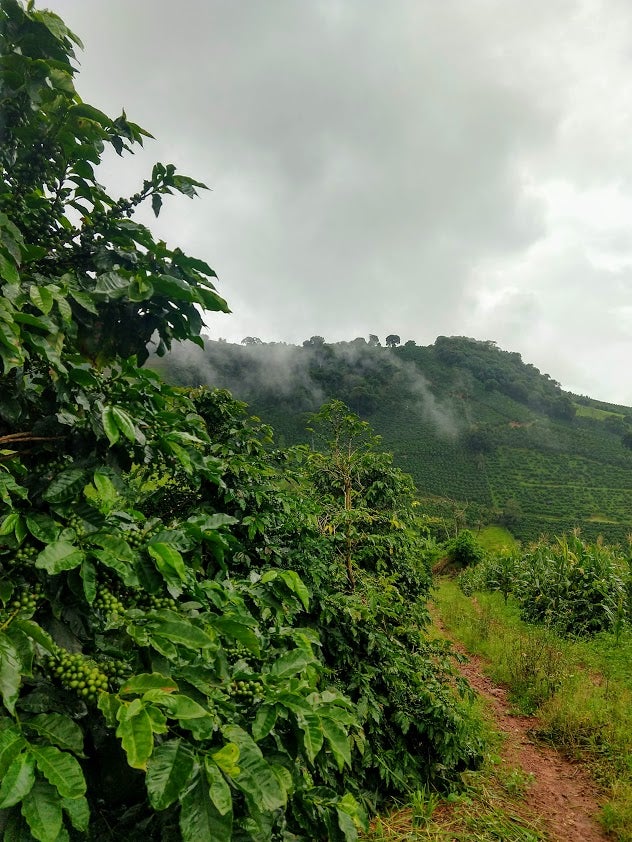From the Field
Monday, October 14, 2019
An Update on Brazil
An unavoidable truth of our industry is that coffee is an agricultural product. This means that, ultimately, no matter the investment a farmer (or a country) makes in their production or the coffee sector, the whims of nature will always have the final say in productivity and quality in any given year. Nowhere is this more evident this year than in Brazil, where very high temperatures during the pre-harvest period followed by unseasonable downpours have had a major impact on the country’s high-quality coffee production in 2019.

What’s the problem?
Weather conditions have significantly impacted the quality of this year’s crop. March is a key month for cherry development in Brazil’s key specialty regions. The weather cools down just around the time that the green cherries are developing and ripening. However, this year the temperature not only stayed high – it soared. Rather than slowly maturing over the course of the season, green cherries began to dry out and shrivel on the tree. This coffee is salvageable and saleable, but it won’t be the high quality that many farmers in areas like Minas Gerais have become known for. The impact is particularly felt on pulped natural (semi washed) coffees. One farmer in the region, reports Bloomberg News, stated in May that he expected to produce fewer than 1,000 bags of pulped natural this year, only a fraction of his overall production and less than half of what he had forecast.
The overall reduction in pulped natural coffees has been exacerbated by unusually high rainfall during the harvest season. Most producers in Brazil dry their coffee on patios, as they can usually count on dry conditions through the harvest season. This year, however, rains have come during key drying times, increasing the incidence of Rio (phenol) and overall lowering the quality of coffee.
One implication of this, according to Rafael Amaral, Specialty Supply Chain Coordinator for Sucafina in Brazil, is that it has created something of an internal black market for pulped natural coffees. Due to shortfalls, many producers have found themselves unable to fill contracts that they signed last year for these desirable coffees. They have been forced to find the coffee elsewhere, from other producers. The prices are high – much higher than in normal circumstances. This means that producers who are trying to fill their contracts risk paying more than they are earning for their higher-quality lots.
Despite the reduced output of higher qualities, productivity has remained high due to new areas of Brazil ‘coming online’ as coffee-producing regions. This has multiplied problems for producers twofold as oversupply and lower-quality beans drive prices down.
What it Means
Although it is estimated that low-quality coffee will account for as much as 25% of the total Brazil output this year compared to the normal 10% annually, we are still importing very good quality coffee this year. Our relationships in Brazil are strong, and we’ve been working with farmers to ensure that we are able to continue to supply clients with the high-quality specialty lots they expect while also remaining supportive of our suppliers in this trying year. The qualities will definitely see the impact of this year’s poor growing season, as we’ve seen throughout Brazil. However, those we work with are already taking measures to make sure that Brazil Specialty has what it takes to see it through.
In short, this year, though we’ll still be receiving many quality coffees, we already know that: we’ll see smaller top-quality lots and the lots we do receive are projected to arrive slightly behind schedule.
Considering these factors, we are advising our clients to evaluate different processes and farms to see if there are alternative coffees that might also meet their needs. We have quite a few new additions to our offer list and are happy to send samples.
A Look into the Future
The truth is – this is likely to be a long-term challenge. The 2020 harvest has also already been impacted by unusual weather. The combined effects of low rain and high temperatures have wreaked havoc on blossoming coffee plants. As of September, the temperature in Minas Gerais was an average of 13 degrees Celsius higher than average seasonal temperatures, and there had been little-to-no rain for nearly 3 months. While early October brought some relief with the flowering of many trees, the weather forecasts for the coming months seem to indicate that there will not be the 50 millimeters of rain necessary to turn flowering blossoms into cherry. Further, while recently images of flowering plants have been plastered across social media sites, growers and experts on the ground report that many farmers, especially those lacking irrigation and other technologies, were not seeing comparable levels of flowering on their trees, if at all.
Solutions are real and are already being implemented. Many farmers are investing in irrigation, which helps mitigate the impacts of climate volatility while having the added benefit of standardizing cup profile and screen size. More and more farmers are investing in drying infrastructure with covered patios and raised beds, helping to ensure more predictable and even drying in a range of weather conditions. Finally, many are starting to invest in selective picking rather than strip-picking. Selective picking is admittedly more laborious (always an issue in Brazil, where labor costs are high), requiring multiple passes throughout the harvest season instead of the single pass needed for strip-picking. But it results in a more reliably quality product. Furthermore, the Brazil Government has already instigated projects to advise farmers on post-harvest procedures. The project is ongoing and only reaches a few farms at a time, but the results already look promising.